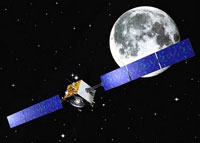欧“智能1号”飞船成功撞月
[ 2006-09-04 14:26 ]
|
 |
Europe's first spacecraft to the
moon ended its three-year mission Sunday by crashing into the lunar surface
in a volcanic plane called the Lake of Excellence, to
a round of applause in the mission control room in Germany.[AP]
|
Europe's first
spacecraft to the moon ended its three-year mission Sunday by crashing
into the lunar surface in a volcanic plain called the Lake of Excellence,
to a round of applause in the mission control room in Germany.
Hitting at 2 kilometers per second, the impact of the SMART-1
spacecraft was expected to leave a 3-meter-by-10-meter crater and send
dust kilometers above the surface.
Observatories watched the
event from Earth and scientists hoped the cloud of dust and debris would
provide clues to the geological composition of the site.
"That's it -- we are in the Lake of Excellence," said spacecraft
operations chief Octavio Camino as applause broke out in mission control
in Darmstadt, Germany. "We have landed."
Minutes later, officials showed off a picture captured by an
observatory in Hawaii displaying a bright flash from the impact.
Launched into Earth's orbit by an Ariane-5 booster rocket from Kourou,
French Guiana, in September 2003, SMART-1 used its ion engine to slowly
raise its orbit over 14 months until the moon's gravity grabbed it.
The engine, which uses electricity from the craft's solar panels to
produce a stream of charged particles called ions, generates only small
amounts of thrust but only needed 80 kilograms of xenon fuel.
The craft's X-ray and infrared spectrometers have gathered information
about the moon's geology that scientists hope will advance their knowledge
about how the moon's surface evolved and test theories about how the moon
came into being.
The spacecraft has also been taking high-resolution pictures of the surface with
a miniaturized camera.
(Agencies)
|
周日,欧洲首架探月航空器结束了三年探月之旅,成功击中月球表面的“卓越湖”火山平原,此消息让德国的地面控制大厅里爆发出热烈的掌声。
这架名为"智能1号"的探测飞船的撞月速度为每秒2公里。按照此速度,这次撞击预计会在月球表面留下一个直径3米,深10米的坑,而且会在月面激起几公里高的尘埃。
很多观测站在地表观测了撞击全过程,科学家希望撞击所激起的尘云和碎石能为研究“卓越湖”区域的地质构成提供依据。
位于德国达姆施塔特的控制中心爆发出热烈掌声,探测器地面指挥所负责人奥克塔唯奥·卡米诺说:“成功了!我们撞上了卓越湖区!我们着陆了!”
几分钟过后,地面指挥所的官员公布了一张位于夏威夷的某观测站拍摄到的“撞击亮光”照片。
2003年9月,“智能1号”探测器从法国圭亚那地区的库鲁基地由Ariane五号火箭发射升空,在其离子引擎的推进下,“智能1号”缓慢脱离运行轨道,在14个月后进入月球重力场。
离子引擎将航天器太阳能面板所采集的太阳能转化为电能,再生成带电的离子流。太阳能离子引擎所产生的推动力并不大,但所需要的氙气燃料也很少,只有80千克。
“智能1号”的X光和红外线分光仪采集了关于月球地质的很多信息,科学家们希望这些信息能够丰富他们有关月面进化的知识,并能为检验月球形成的各种理论提供依据。
“智能1号”上还装有一个微型照相机,它拍摄了很多高清晰的月面照片。
(英语点津姗姗编辑)
|
|
|
Vocabulary:
|
|
obervatory: 观测站;天文台
high-resolution
picture: 高清晰照片
|
|
|
|